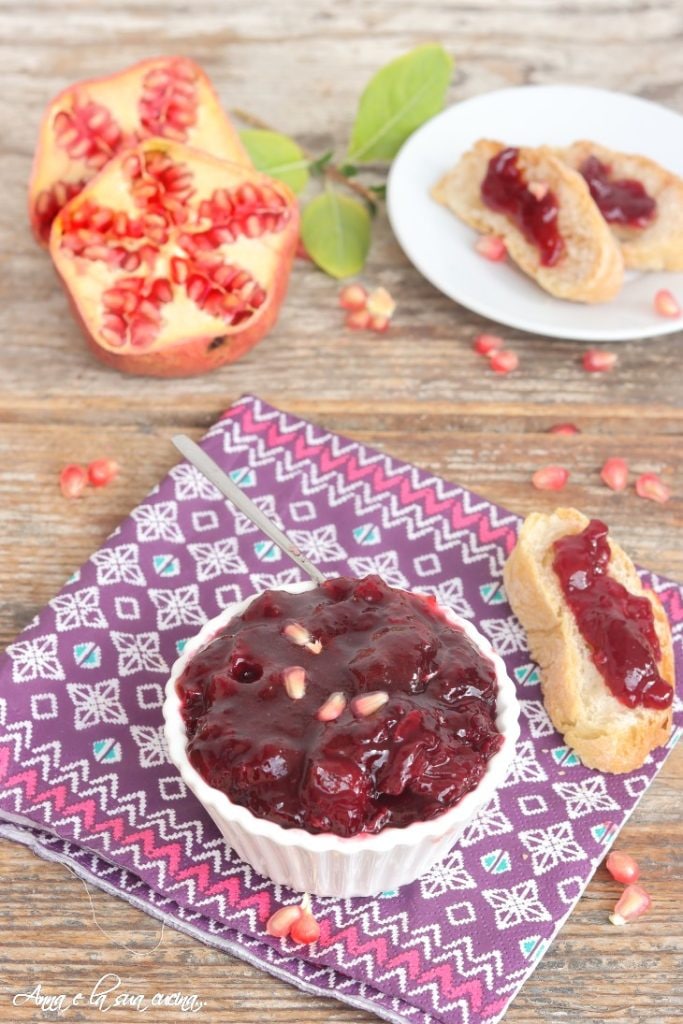Pomegranate Jam without Pectin or pomegranate jelly is an excellent preserve with a slightly tangy taste, delicious spread on a simple piece of bread to enjoy for breakfast or a snack, to fill our pies or other sweets.
Pomegranate jam, like persimmon jam, is very versatile and therefore perfect to enjoy with aged cheeses or to flavor sauces for meat and fish.
To prepare the jam or jelly, the fruit must be well ripe with plump seeds to avoid it becoming too sour; to avoid using commercial pectin, it’s better to add an apple or more depending on the quantity, as it is essential due to the pectin (mostly contained in the peel) which will make the jam more gelatinous.
There are several ways to prepare this preserve; some let the seeds macerate overnight with lemon and sugar, then cook these seeds (arils) and strain them at the end, others use a juicer to get the juice, or the simplest and fastest method I used by using a citrus juicer or a potato masher, so you get the juice directly.
The fresh pomegranate juice obtained is then cooked together with sugar and lemon juice, while the apple slices will help give a creamy consistency thanks to the thickening power of the pectin; at the end of cooking, blend everything and pour it into jars.
Pomegranate is a fruit rich in vitamin C, it acts as a powerful antioxidant and therefore protects tissues from wear and attacks by free radicals.
Don’t miss other tasty ways to use it in the kitchen, here they are!

- Difficulty: Easy
- Cost: Medium
- Preparation time: 20 Minutes
- Portions: 2 small jars
- Cooking methods: Slow cooking, Stove
- Cuisine: Italian
- Seasonality: Autumn, Winter
Ingredients for Pomegranate Jam
- 7 pomegranates (16 oz of juice)
- 150 g sugar
- 2 lemon juice
- 1 apple
Tools
- 1 Citrus Juicer
- 1 Pot
- 2 Jars
Steps for the Jam
Wash the pomegranates’ peel well, take a cutting board and with a good knife cut the pomegranate in half, be careful of the staining juice.
Take a citrus juicer and start juicing the first half of the fruit, as you would for a lemon or an orange, juice very well to extract as much juice as possible.
Continue like this until the last pomegranate, occasionally clean the container to avoid blocking the juice flow, then pour the juice into a pot.
I used 7 medium pomegranates and obtained about 16 oz of juice.
The color of the juice varies based on the color of the pomegranate.

Also clean the apple, remove the core, and cut it into cubes, pour it into the pot along with the pomegranate juice, also add the juice of the 2 lemons and sugar.
COOKING
Bring the pot to the stove and cook, stirring often with a wooden spoon, until it starts to thicken a bit.
During cooking, a white foam may form on the surface, remove it with a skimmer.With an immersion blender, blend the mixture until it becomes creamier, return to the heat and cook further until it thickens, it will take about 40 minutes in total.
At this point, with a ladle, pour the jam into previously sterilized jars, close them tightly, then cook the full jars of jam, well closed, in boiling water for about 20 minutes, separated from each other with cloths.
This is to create a vacuum seal and preserve the jam for a long time.
The final sterilization offers more product safety with longer preservation compared to those who use the vacuum method with jars turned upside down while still hot.
Let the jars cool inside the pot, when they are cold, check the vacuum seal: you can press the center of the lid, and if you do not hear the classic “click-clack” the vacuum is successful, otherwise change the lid and redo the sterilization or store in the fridge and consume within 2 days.
Dry, date, and store the product in a cool, dry pantry away from sources of light and heat for over 6 months.
Storage
Pomegranate jam, if sealed well hermetically, keeps for over 6 months.
If you use even more sugar, an excellent preservative, it keeps for over a year
Once opened, store the jar in the fridge and consume within a week.
Once opened, store the jar in the fridge and consume within a week.
Useful tips for storage
For proper homemade preserves preparation, refer to the guidelines of the Ministry of Health.
It is a list of kitchen, personal, and tool hygiene rules, ingredient treatment, pasteurization, and preservation, to avoid health risks.
Information
The difference between marmalade and jam depends on the type of fruit; marmalades are made with citrus fruits: oranges, mandarins, bergamot, citrons.
Jams, on the other hand, are made with all other types of fruit: peaches, apples, apricots, strawberries, etc.
Here are some recipes: Organic orange marmalade – Mixed mandarin and kumquat marmalade – Apple and cinnamon jam – Sterilized quince jam Persimmon jam with cinnamon
FAQ (Questions and Answers)
Can I add pectin?
If you prefer to facilitate thickening, you can use commercially available pectin. I preferred a natural preserve using an apple that contains natural pectin.

